Siphon for a shower - types, features of the choice and
In order for the shower tray to work properly, you need to find a suitable siphon for it. At present, there are quite a few variants of these devices, for example, there is a siphon for a shower in the floor or a flat construction that is attached to the pallet, which complicates the choice. To help in this matter below, we take a closer look at the types of these devices and the features of their choice.
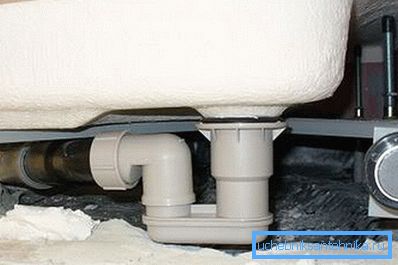
Siphon selection
General information
Siphon is one of the most important elements of the drainage system, since it performs the following functions:
- Provides discharge of sewage into the sewer;
- Provides a water seal that prevents evaporation from the sewage into the room.
- Detains large debris and thereby prevents clogging of the sewage system.
The device works on the following principle:
- Water from the shower enters the drain hole.
- Then through the release of the sewers fill the flask.
- Then the water, bypassing the pipe-sump, falls into the sewer.
Despite the fact that any siphon for a shower tray with a hydraulic lock works according to the principle described above, there are quite a few varieties of sinks, which we will discuss below.
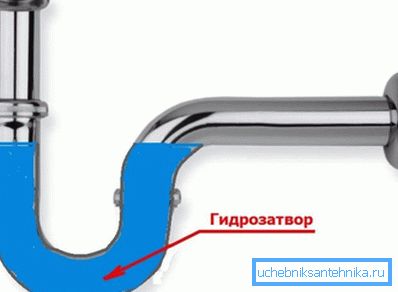
Kinds
By type of construction siphons can be divided into the following types:
| Type of construction | Description |
| Tubular | It is a bent nozzle, which consists of several parts. The advantage of this design is a reliable water seal, however, it requires quite a lot of space between the shower and the floor, so during installation you may need to lift the pallet. |
| Ladder drain | It is a flat device, the height of which is usually only 10-20 millimeters. Due to such compactness, the shower can be located quite low from the floor. The only thing in this case is that the water lock is weaker, as a result of which its breakdown is not excluded. Similar problems can arise if there are minor violations of the ventilation of the sewer system. There are two types of trap-plums:
|
| For floor mounting | Structurally, it resembles an ordinary ladder-drain, however, it is designed to drain water directly from the floor, respectively, the product is built into the floor. |
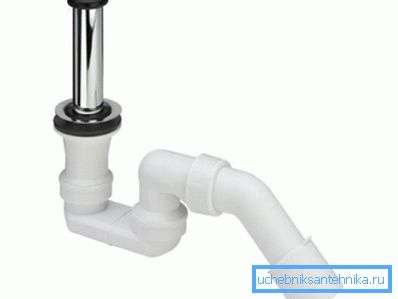
Tip! The built-in ladder-drain can be used for arrangement of emergency discharge that will allow to avoid flooding of housing.
Selection features
To correctly select the siphon, you need to consider a number of factors that are listed below:
- The first step is to measure the diameter of the drain hole of the pallet.. Currently available for sale is a 50 mm, 60 mm and 90 mm siphon for a shower tray. If you choose the wrong diameter, it will not be possible to install it, or the installation will be leaking. I must say that the diameter of the drain depends on the height of the pallet. When the diameter of the drain is not more than 50-60 mm, the height of the container does not exceed 12 cm. With a diameter of 90 mm, the height must be no more than 15 cm.
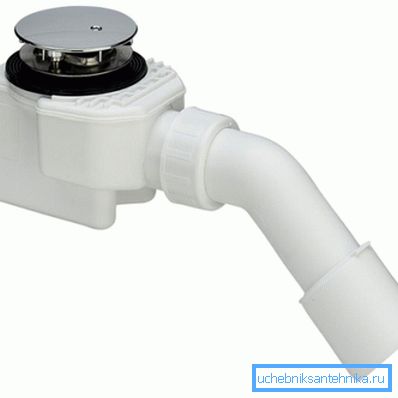
- Design features of the drain - some models have a self-cleaning function. In addition to the sale you can find models with a valve for draining, as a rule, they are used in conjunction with deep pallets, which are designed to draw water. Of course, the more features a device has, the higher its price.
- The distance from the floor to the pallet - depends on the height of the drain.
Tip! Siphon for a shower tray of 90 mm can be cleaned through the drain hole. If the diameter of the drain is smaller, it will be necessary to disassemble the structure to clean it.
Having decided on all these moments, it will not be difficult to choose a suitable product.
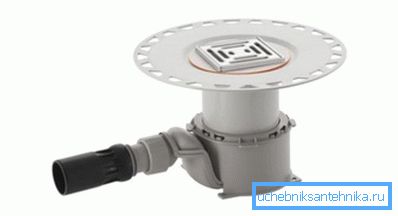
Installation Features
After acquiring a siphon, you can install it yourself, without the help of specialists. The principle of installation does not differ from the installation of a sink to the sink or, for example, a bath.
The main thing is to get acquainted with the scheme of its assembly - the installation manual is surely included in the kit.
In addition, you must adhere to the following recommendations:
- Drain should be located 5-7 centimeters above the entrance to the sewer pipe.
- To ensure normal flow, the sewer pipe must have a slope of one and a half centimeters per meter.
- If the cabin is located far from the sewer entrance, a special sewage pump should be used.
- After installing the siphon, the pallet must be placed in a horizontal position. No deviations should be performed.
- All connections must be missed with silicone sealant to avoid leakage.
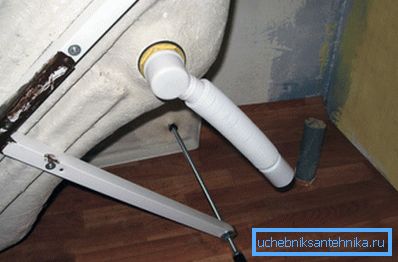
Tip! When connecting the drain to the sewage system, it is best to use corrugated pipes, as they are adjustable in length, which greatly simplifies installation.
Here, perhaps, are all the main features of the choice of siphon for a shower and its installation.
Conclusion
Siphon plays an important role in the performance of the shower, therefore, requires a competent approach to the choice. In addition, it is imperative to properly install the device, in accordance with the above recommendations.
You can read some additional information on this topic from the video in this article.